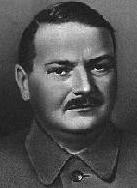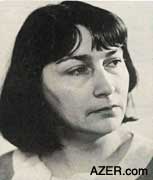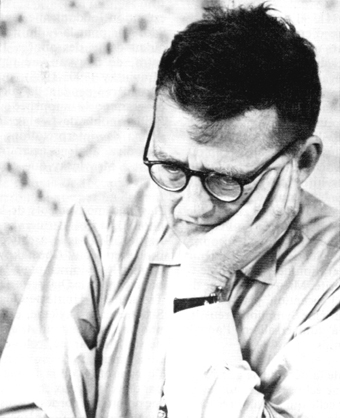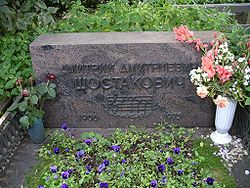Dmitriĭ Shostakovich (1906-1975)
Born September 25, 1906 in St. Petersburg.
Died August 9, 1975 in Moscow.
Symphony No. 10 in E Minor, Op. 93
Composed summer-fall 1953 – possibly earlier.
First Performance: December 17, 1953 in Leningrad with Yevgeni Mravinsky conducting the Leningrad Philharmonic Orchestra.
Instrumentation: piccolo, 2 flutes, 2 oboes, english horn, Eb clarinet, 2 clarinets, 2 bassoons, contrabassoon, 4 horns, 3 trumpets, 3 trombones, tuba, timpani, percussion and strings.
Dmitriĭ Dmitrievich Shostakovich began piano lessons at age nine and continued his studies at the St. Petersburg Conservatory until 1925. His graduation composition was his Symphony No. 1 which propelled him to prominence. His second opera, Lady Macbeth of the Mtsensk District (Леди Макбет Мценского уезда) based on a story by Nikolai Leskov which premiered in January, 1934 was a resounding international success with the public and also Soviet government officials. The story contained not-so-veiled references to the current Stalinist society – even including a scene in a gulag (places which didn’t officially exist). In the January 28, 1936 issue of Pravda an anonymous article – allegedly written by the Great Leader and Friend of Children himself – attacked the opera as “Muddle instead of Music” This lead not only to the opera being banned for almost 30 years but great anxiety for Shostakovich who was now considered an “Enemy of the People”. Remember that this was the time of the purges where Soviet citizens suddenly disappeared. For a time Shostakovich slept with his bags packed, awaiting the knock on the door in the middle of the night. He withdrew his Symphony No. 4 during rehearsals out of fear of reprisal. He simplified his style to avoid being branded again as a composer who could “reach only the effete “formalists” who had lost all their wholesome taste.” His “Soviet Artist’s Reply to Just Criticism”, the Symphony No. 5, restored him to the official’s favor. But only for a while.
Shostakovich once again disappointed the Soviet officials with his Symphony No. 9. That work was more on the scale of a chamber work than a massive proclamation of victory complete with chorus and soloists.

In 1948 the Central Committee led by Zhdanov condemned many composers including Prokofiev and Shostakovich as being “formalist”. Shostakovich was publicly humiliated and was later dismissed from his teaching position at the Moscow conservatory. This had a lasting effect on Shostakovich. His works until the death of Stalin on March 5, 1953 outwardly toed the party line.
It is in this light that his statement regarding the Symphony No. 10 that “in this work, I wanted to convey human feelings and passions” should be viewed. Inwardly Shostakovich scattered hidden meaning throughout his compositions via quotations of his and other works as well as a personal musical steganography. We get glimmers of this when in the first movement of the Symphony No. 10 when he quotes the second monologue from his song-cycle Four Pushkin Monologues, “What is in My Name?”. You know that the famous DSCH motif (taken from the German transliteration of his name D. Schostakowitsch) will make an appearance as it does in the Cello Concerto we heard last season as well as many other late works. In fact this motif appears on his tombstone in the Novodevichy Cemetery.
In 1979 Solomon Volkov published Testimony: The Memoirs of Shostakovich which continues to produce controversy. In it Shostakovich admits to including covert messages in music that could outwardly be interpreted as true Socialist Realism.
On the Symphony No 10 Shostakovich writes in Testimony, “I did depict Stalin, I wrote it right after Stalin’s death, and no one has yet guessed what the symphony is about. It’s about Stalin and the Stalin years. The second part, the scherzo, is a musical portrait of Stalin, roughly speaking. Of course there are many other things in it, but that is the basis.” We will see “what no one has yet guessed” in the third movement.
The Symphony contains four movements.
I – Moderato
II – Allegro
III – Allegretto
IV – Andante
The sonata form first movement opens quietly with the low strings playing in unison resembling the opening of Liszt’s Faust Symphony. The very beginning contains a motif (marked with an X in the example) that appears frequently throughout the symphony. In fact the first three movements begin with a variation of it. It has been colorfully described as the “motif of the evil”. The final fugue from his 24 Preludes and Fugues, op 87 is also in evidence here.
Example 1. First movement
The brooding solo strings playing the first theme are followed by the second theme played by the solo clarinet which is in turn followed by the third theme played by the flute.
The development quietly begins with bassoons, contra bassoon and timpani. The movement ends as it begins – in gloom.
The second movement is the “music portrait of Stalin.” It begins with brutal pounding minor chords along with the X motif.
Example 2. Stalin
Above the strings we hear the winds play another theme. It has been noted that the second movement’s theme not only contains the X motif but is also very similar to the opening theme of Boris Godonov.
Example 3. Second movement theme
The allegretto third movement begins quietly with the string playing a theme once again based on the X motif. The first four notes are also the DSCH motif but out of order.
Example 4. Third movement
Soon we hear the DSCH motif in the winds along with a characteristic anapest rhythm which some writers associate with the spoken rhythm of Mityenka – a diminutive form of Dmitriĭ.
But then we hear a solo horn that resembles the opening horn theme from Mahler’s Das Trinklied vom Jammer der Erde from Das Lied von der Erde. This horn solo returns intact with no modification twelve times in the movement. What could this possibly mean?
Alban Berg’s Lyric Suite (1925-1926) contains a secret program that was undiscovered for many years. In 1990 George Perle revealed that Berg derived motifs from his musical initials AB with HF, those of his mistress Hanna Fuchs-Robetin.

More recently, Nelly Kravetz published an article that shed light on the part that “no one has yet guessed [is about]” namely the third movement. Azerbaijani pianist and composer Elmira Nazirova, had studied with Shostakovich in 1947. During the composition of the Symphony No. 10 Shostakovich engaged in a detailed personal correspondence with Elmira who served as his muse rather than mistress during this trying time for him. Using both note letter names and solfeggio syllables Shostakovich turned “Elmira” into the mysterious horn motif.
Example 5. Motifs based on names
Shostakovich wrote Elmira that he played Das Trinklied vom Jammer der Erde noting that the horn theme represents the cry of the monkey which he described as a Chinese symbol of death, cruel fate, and unhappiness. He thought it might be an interesting topic for musicological research.
At the close of the movement we hear both monograms appear simultaneously; Elmira by a solo horn as always, DSCH by flute and piccolo.
The finale begins with a pensive oboe solo.
Example 6. Fourth movement oboe solo
The theme is taken up by the rest of the winds. Soon we hear snippets in the winds of a dotted rhythm with the interval of a fifth. This leads into the Hopak (folk dance) main theme of the movement which starts with this rhythm and interval.
Example 7. Fourth movement “Hopak” theme
The cheerfulness of the finale still puzzles listeners when placed in contrast of the unremitting gloom of the first three movements. The DSCH motif is in full force here as if to say Stalin is dead but I live. Perhaps this cheerfulness is Shostakovich’s nod to Socialist Realism by providing an “uplifting” and “optimistic” conclusion – or an Artist’s response to unjust criticism from a brutal oppressive regime.
Resources
[amazon template=iframe image&asin=0486288013][amazon template=iframe image&asin=B000005E83][amazon template=iframe image&asin=B000005824][amazon template=iframe image&asin=B000001GQZ][amazon template=iframe image&asin=B000063UM3][amazon template=iframe image&asin=B000079BGH][amazon template=iframe image&asin=B002EIJ8TA][amazon template=iframe image&asin=B0000AN4FJ][amazon template=iframe image&asin=B000050XA2][amazon template=iframe image&asin=087910998X][amazon template=iframe image&asin=B000G1ALES]








